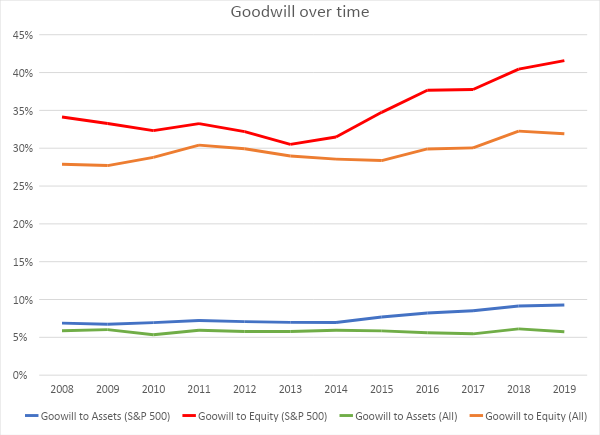Do We Have a Goodwill Bubble? Goodwill is an accounting concept that represents the amount an acquiring company pays for a target beyond that target’s identifiable assets.
More technically — goodwill is the premium the acquirer pays for the net assets it buys while acquiring the target. Goodwill might represent the target’s brand reputation among customers, the loyalty and skill of employees, the potential future growth in earnings thanks to those things, and so forth. It’s a proxy for the synergies the acquirer hopes to achieve from the acquisition and use of the target’s assets.
One important point: goodwill only appears on a company’s balance sheet when the company completes an acquisition. You don’t get to record goodwill assets for whatever brand reputation, employee loyalty, and the like that your company might generate naturally.
For the last 20 years, accounting rules have directed companies to record goodwill as an asset on their books and test it annually for impairment. Goodwill also tends to accumulate over time — because companies do more deals, which means more goodwill, added to whatever goodwill you were already carrying.
The practical result: over time, goodwill becomes a more and more significant part of the corporate balance sheet. The only time when goodwill might decrease is when the company decides that, oops, those expected synergies didn’t materialize like we expected, so we need to write off (that is, impair) part of the value.
Our Bubble Theory
So how much is goodwill accumulating on corporate balance sheets? We decided to investigate.
To do that, we examined goodwill as a percentage of total assets and of stockholders’ equity (net assets) for both the S&P 500 and all companies. To calculate the percentage, we summed up goodwill for all companies in each group, and then divided that number by the sum of total assets or shareholder equity.
As you can see from the chart below, goodwill represents about 5 to 10 percent of total assets, and 30 to 40 percent of equity. S&P 500 companies have more goodwill on their books, which is understandable because they engage in corporate acquisitions more often.
We can also see that goodwill is increasingly a more significant part of companies’ balance sheets; the lines fluctuate from year to year, but the trend for all four is unmistakably up.

Is this a bubble that may burst?
For all companies collectively, perhaps not. We’d need some widespread, long-term, cataclysmic economic event to trigger massive impairments, and even amid today’s tumultuous circumstances, that seems unlikely.
For specific industries, on the other hand, that’s much more possible. Consider how the pandemic hammered tourism, retail, and hospitality. Or perhaps rising interest rates would trigger an economic squeeze in a sector like real estate.
You get the idea. We might not be in the midst of one massive goodwill bubble, so much as we’re floating along numerous smaller, industry-specific bubbles. Which ones might burst? How much splatter would that generate?
Calcbench itself isn’t sure. But we do have the data to let you conduct your own investigation— and if you find something interesting, you’re always welcome to drop us a line at info@calcbench.com.
(For additional analysis of goodwill, check out a comment letter sent by the CFA institute to the FASB here.)